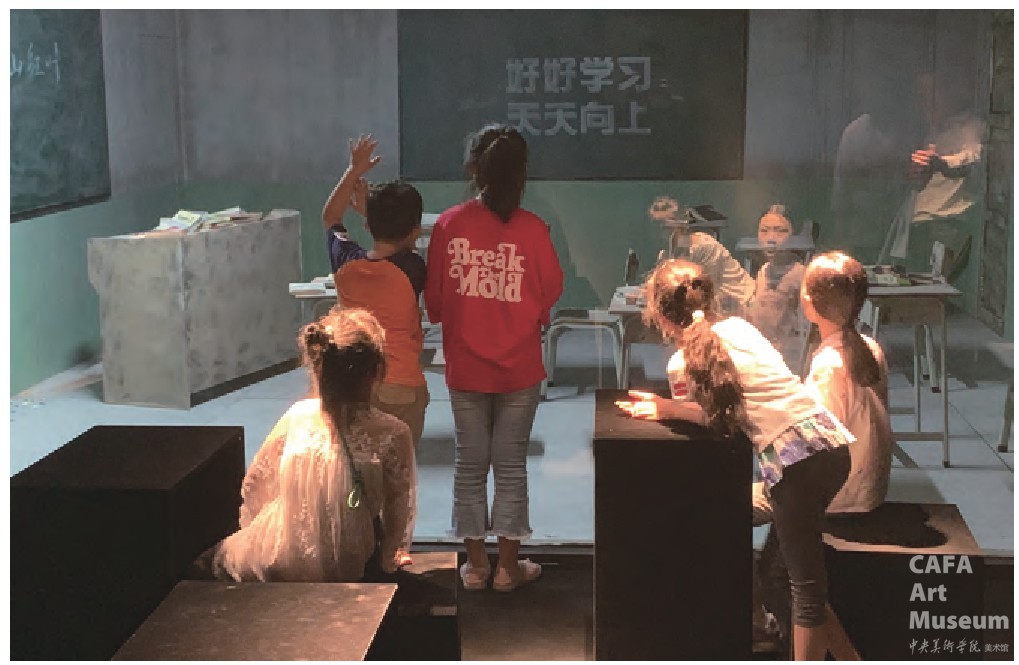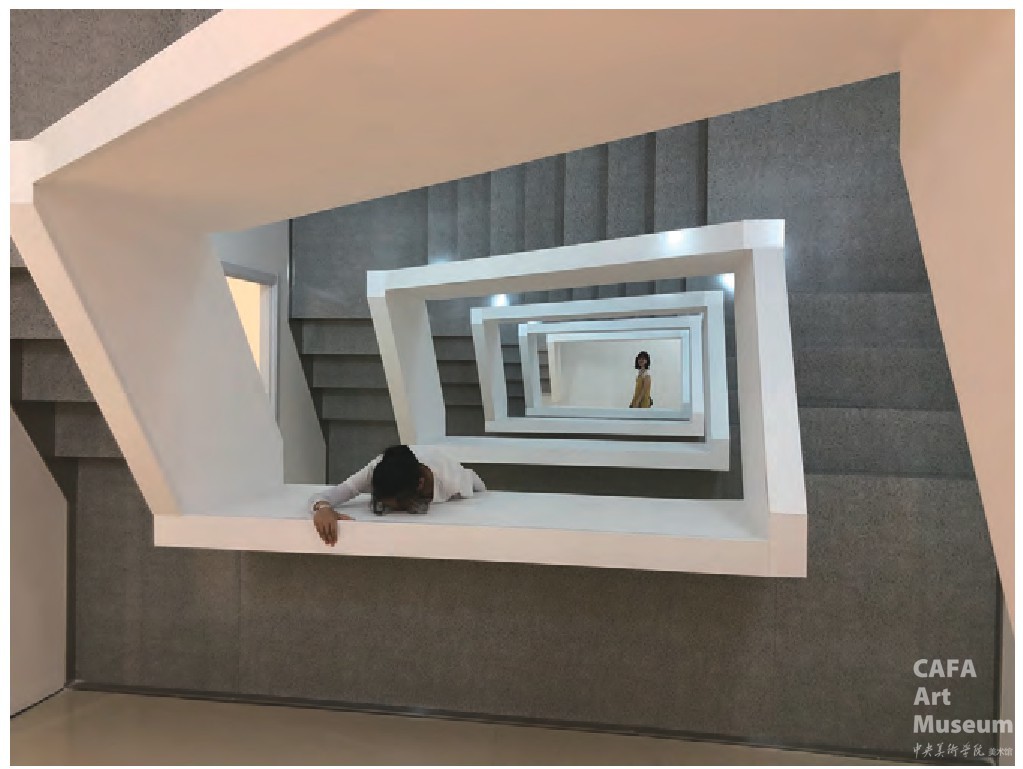
“我拒绝一成不变看待事物的方式,因为我们可以有更多的方式来观察现实。”
——雷安德罗·埃利希
自阿根廷艺术家雷安德罗·埃利希(Leandro Erlich)携其个展“太虚之境”于7月11日亮相中央美术学院美术馆以来,人们排着长队等待体验每一件作品,进入作品内部、围绕作品周围或趴或躺、或站或卧拍着姿态各异的照片,并将之发送到不同的社交平台分享各自的惊奇体验,在京城掀起了一阵埃利希旋风。埃利希此次在中央美院展出的作品,利用建筑空间、镜子、窗户、视频、声音等媒介,让观众置身在一幕幕日常生活场景中,通过眼睛的视错觉功能,产生一种反常的疑惑心理,透过感官达到丰富认知框架的结果。本文将重点探索触发这一结果的机制,从解读展览主题“太虚之境”入手,将中国传统的“迷津”文化逻辑和博尔赫斯惯常使用的“迷宫叙事”方法相联系。埃利希借用这种“迷津”和“迷宫叙事”的逻辑,利用展览地点和作品建造了一个福柯所说的“异托邦”,又让观众在观展过程中同时经历了虚幻的乌托邦世界(镜子里的、屏幕中的)。正是这种将乌托邦和异托邦并置的手法使虚幻和真实的世界被同时感受,导致了观众自发地产生质疑进而构成新的视觉经验的结果。
“迷宫叙事”与异托邦
雷安德罗·埃利希一直以来被认为是“艺术界的博尔赫斯”。如果我们接受这一称谓,就可以发现在埃利希的作品、博尔赫斯(Jorge Luis Borges)的“迷宫叙事”以及福柯定义的《异无托名气邦“旋”》之间20存17年在着一条内在逻辑。评论界常常用“幻想小说”“玄想小说”概括博尔赫斯的创作。梦、迷宫、镜子、废墟、花园、旋转的楼梯、大百科全书等等,都是他玄想的内容,“‘迷宫叙事’”是博尔赫斯玄想的重要组成部分。“迷宫”特征表现为叙事中有叙事,就像进入迷宫中的道路,分岔中有分岔,每次分岔都引出新的道路,可以无限地重新组合生成新的组合,使故事无穷尽地衍生下去,每一个岔路都孕育着新的叙事基因,表现出对无限可能性的追求【1】。博尔赫斯曾经杜撰过一部“中国百科全书”,里面介绍了中国的动物分类方法【2】,这个文本让福柯获得《词与物》一书的灵感,福柯认为博尔赫斯那看似荒唐的分类结果,动摇了用来安顿大量存在物的所有秩序井然的表面和所有平面,瓦解了我们自古以来对同和异的区别【3】。他描述“异托邦”是扰乱人心的,可能是因为他们秘密地损害了语言,阻碍了命名这和那,破碎和混淆了通用名词……促使词与物“结成一体”(一个接一个地,还有相互对立地)的不太明显的句法。【4】

雷安德罗·埃利希 《拔地而起》 2015年 综合材料 尺寸可变 2019年于中央美术学院展出现场 图片由中央美术学院美术馆提供

雷安德罗·埃利希 《建筑》 2019年 写真布喷绘、灯、铁、木和镜子 图片由中央美术学院美术馆提供

雷安德罗·埃利希 《反射港湾》 2014年 金属框架、覆板、船 尺寸可变 图片由中央美术学院美术馆提供
福柯认为“异托邦”能够再现、连接、反抗甚至颠覆所有的常规场所,这里我们需要再次强调埃利希的建筑师身份,他的作品常常是根据场地现场建造一个真实的、等大的日常生活空间,我们可以在观赏艺术品的空间(博物馆等)观看作品,并进入作品内部,在其中体验到另一个不同意义的空间。如《教室》,我们进入名为教室的空间,除了黑色的方块告知我们桌子、椅子、讲台和黑板的位置以外什么都没有,我们必须坐在指定的位置上,从身体右侧的玻璃的反光中看到自己似乎位于一件上世纪80年代的教室里,这里出现了三个空间的叠加——美术馆的空间、作为艺术品的教室的空间以及80年代教室的空间。这不光符合福柯所说的“异托邦”的六个特征中第三个特征异质性,还符合第四个特征“异时性”,即时间的异质化。福柯在解释“异托邦”时曾用博物馆和图书馆举例,他认为“异托邦”中的时间能够无限积累下去,许多文物和文献产生于不同的时间,却都以不完整的状态出现在同一地点(博物馆和图书馆)内部,博物馆和图书馆承载了时间和历史,将不同时间和历史阶段的多种文化同时体现。它们将历史和知识以不完整的、排列的方式保存下来再展现在人们面前,由此能够无限地、永恒地持续积累下去,最后拥有全部时间的地点。除了这种无限的、永恒的“异托时-异托邦”之外,福柯认为还有另外一种状态,这种状态相对于前者而存在,那就是短暂的、瞬间的“异托时-异托邦”,代表的时间更为短暂而支离破碎,没有任何稳定性可言,节日就是其中代表。【5】埃利希作品展览的时效性,导致整个展览都具有了典型的短暂的“异托时-异托邦”特征。
映像中的“乌托邦”
福柯是从乌托邦的概念出发解释“异托邦”的。他认为乌托邦提供了安慰:它们没有真正的所在地,但是存在着一个奇异的、平静的区域;它们开发了拥有康庄大道和优美花园的城市,展现了生活轻松自如的国家,虽然通向这些城市和国家的道路是虚幻的。【6】这次埃利希在中央美院的个展展出了20件作品,镜子和映像被反复使用,造成了观众视错觉的感受。利用福柯的观点,“镜子毕竟是一个乌托邦,因为它是一个非场所性的场所。”【7】因为镜子中的世界是非真实的世界,在埃利希的作品中确实存在乌托邦和异托邦的某种交汇。“当我在镜子中看到我自己的那一刻,镜子使得我与我占据的空间(变得)真实,因为它关联着周围的整个空间;但它又完全不真实,因为不得不通过某种在那个地方的虚拟点来感知。”【8】所以在这里,镜子也把我们引向了乌托邦的世界。最能体现福柯对镜子的描述的是《建筑》这件作品,我们在建筑里面摆出各种姿势,在上方的镜子中看见自己飞檐走壁的身影;《迷失花园》这件作品被安置在美术馆二层,首先围着这件作品转一圈会发现,从外观上看,这座花园的外形是一个三角体。透过窗户往里面看,能发现这位来自遥远的南美的艺术家给我们设计了一座中国人非常熟悉的四合院里的花园,符合中国人对于文人生活方式的想象。但是花园没有入口,你永远无法进入其中,就像博尔赫斯虚构的中国的迷宫一样,只是这一次你不需要阅读和想象,埃利希直接把虚幻的空间放到了观者的面前。人们可以在《游泳池》里自由呼吸,完成成为另外一种生物的想象;《人行道》是埃利希的录像装置,在这里也用到了映像的手法,观者从埃利希设计的人行道上走过,旁边的水洼就反射出街道上的建筑的图像,还配合着昼夜的转化,让观众体验到更大的空间和时间的流逝;《悬浮电梯》里孕育了无限的空间,感觉能上天入地,暗合了中国的一句古话“方寸之间,心游万物”……

雷安德罗·埃利希 《教室》 2017年 木、窗户、桌椅、门、玻璃、灯 尺寸可变 图片由中央美术学院美术馆提供

雷安德罗·埃利希 《迷失花园》 2019年 金属框架、砖、窗户、镜子、日光灯和人造植物 尺寸可变 图片由中央美术学院美术馆提供

雷安德罗·埃利希 《试衣间》 2008年 嵌板、镜框、镜子、凳子、帘子和灯 尺寸可变 图片由中央美术学院美术馆提供
从“太虚之境”暗示异托邦和乌托邦并置的空间
埃利希在接受采访时强调,展览主题“太虚之境”来源于《红楼梦》第五回所描述的“太虚幻境”。“太虚幻境”乃是贾宝玉在秦可卿闺房中梦见的一处虚幻的仙境花园,这处花园位于离恨天之上、灌愁海之中放春山遣香洞,我们可以认为这是一处贾宝玉梦中的极乐世界,即贾宝玉的“乌托邦”。据考证,“太虚幻境”的典故脱胎于《列子·周穆王》所描述的“神游之境”,晋人张湛注解“神游之境”谓之“太虚恍惚之域”。周穆王到达这个“神游之境”的方法,是由来自西极之国的化人“变物之形,易人之虑”。【9】《红楼梦》中正是秦可卿卧房里的陈设(物形)刺激了宝玉的“人虑”,使其脱离了真实的状态,进入了“恍惚”的虚幻梦境,但是作为凡人的贾宝玉最后又不得不通过“迷津”【10】回到现实之中。正如这处花园的对联所写:“假作真时真亦假,无为有处有还无”,贾宝玉在恍惚之间经历了真实和虚幻的转换。曹雪芹作为“化人”在秦可卿卧房里设置了一个真实的空间,但是摆放的却是唐伯虎画的《海棠春睡图》、“秦太虚的对联”“武则天的宝镜飞燕舞过的金盘安禄山伤了太真乳的木瓜”“寿阳公主的榻”“同昌公主的联珠帐”“西子的纱衾”“红娘的鸳枕”【11】等充满寓意的物件,这是一处典型的福柯的异托邦的铺陈,贾宝玉正是借由此处在睡梦中神游了他的乌托邦——“太虚幻境”,两处世界就连接在“迷津”中。
“迷津”,《说文》中解释“津,水渡也”,即河湖的渡口。在佛教用语中“迷津”又称“迷妄的境界”,我们平常往往希望有高人能指点迷津。在中国传统文化中,“迷津”的指向常常被“桃花源”代指,宋词人秦观就曾说道:“雾失楼台,月迷津渡,桃源望断无寻处”;《桃花源记》中太守和南阳刘子骥都曾寻找桃花源之所在,结果却是“皆迷,后遂无问津者”。所以“迷津”就是指代那个迷失道路的地方,与这个迷妄的境界相对的肯定还有另外一个不迷妄的境界,两者由“津”所连接。桃花源在中国传统文化中被指代为人性内部的终极希望、梦幻、理想之所,被认为是超越现实的乌托邦,人们穷极一生设法寻找,却总是迷途半路,衍生出另外的结局。按照“太虚之境”的生产逻辑,埃利希从这个主题就已经向中国的观众暗示了他所想要表达的意图——将异托邦和乌托邦并置,使观众在参观时如同贾宝玉一样在真实和虚幻中同时转换。
埃利希和曹雪芹一样,如同“来自西极之国的化人(神人)”,利用建筑装置的真实空间场景,使进入其中的观众在屏幕、镜头、镜子等媒材中迷失自我,进入恍惚的虚幻之域,再经由瞬间的疑惑即“迷津”中回归现实,如一层大厅中的大型装置《建筑》所示,建筑立面被横放在水平的地面上,一楼的店铺、招牌、铁质的阳台,消防梯,门窗,空调等楼房立面该有的元素一样不少,在它们应该在的位置上,只是随着立面一起被水平地卧在了地面上,人们进入这个作品,躺在“墙壁”上赫然看见一面与建筑等大的镜子以45°角吊挂在自己的上方,镜子中的人们正在飞檐走壁,上下翻飞……这种场景存在于武侠小说的世界里,人们想象着自己的能力和神一样,无所不能——典型的乌托邦的理想得以实现。这一瞬间,观众发现了镜子中的不可思议,进入了恍惚的世界,质疑了我们过往的视觉经验。观众质疑的瞬间就处于“迷津”之中,最终进入恍惚的“太虚”这样一个幻想的境界。

雷安德罗·埃利希 《悬浮电梯》 2019年 金属结构、木、镜子、不锈钢、电梯按钮 225×169×121cm
相较于博尔赫斯小说的文字创作,作为建筑师和艺术家,埃利希采用的是视觉艺术语言,利用建筑空间、镜子、窗户、视频、声音等媒介,直接将“迷宫”搭建出来,不依靠连贯的文字来展示作者的意图,而是直接将观者带入特定的情境,并在情境中发生经验和心理的改变,产生疑惑。在这次展览中,埃利希在作品的设计和搭建时,选取了一系列中国观众日常生活中常见的元素,《美发沙龙》里的塑钢门窗;《建筑》一改法国奥斯陆建筑立面,变成了唐人街的商店招牌和中国字;《连根拔起》也变成了典型的中国砖瓦房;《精神分析师的办公室》则变成了《教室》,呈现了1980年代一所普通的北京高中教室的场景……等等这些元素也是埃利希为我们设置的视觉迷宫中真实的一环,让中国观众在体验中产生亲切感打破了地域和文化的边界与太虚幻境”的生成一样,让观众真正处于一种环境和空间中,同时在感官处打开了一扇经验(真实)之外的惊奇之门,再一次指向了乌托邦的生产。

雷安德罗·埃利希 《央美美术馆楼梯》 2019年 综合材料 尺寸不一

雷安德罗·埃利希 《游泳池》 2004年 铁制钢架、木、钢化玻璃、泳池扶梯 日本金泽21世纪当代美术馆展出现场
埃利希的作品属于特定场域的大型装置作品,这种作品对于私人收藏来说非常困难,通常在展览完成之后就会被拆除,但是在展览期间,又具有了福柯的“异托邦”所界定的特征。不光是《教室》这件作品,我们还可以在其他的作品中发现这种“异托邦”的特征,如《游泳池》。在这件作品中,泳池被放置在美术馆的空间内,被当做了观看的作品,失去了本来的功能。泳池内部被当成了观赏和拍照的场所,这也是空间异质化的一种;《建筑》立面被水平地放置在美术馆一层大厅的地面,建筑内部应该有的空间被阉割,在这里地心引力被抛弃,人们仿佛能够飞檐走壁;关于《雨》这件作品,我们透过窗户看见两栋建筑物之间雷雨交加,通过闪电仿佛看见对面窗户中别人的家,窥视到了别人的房间,转过去对面却发现我们还是处于美术馆的展览空间,与之前窥视的角度一致。可是透过窗户我们仿佛已经进入了另一种空间的想象当中;在《连根拔起》这件作品中可以看到,房子被悬挂在半空中,下面长出的钢铁根须表示其应该呆的位置是地上,一切都引向了一种错乱的感觉,不管是空间放置的错乱,还有空间中暗含的文化的错乱……我们从这个方面来理解,埃利希用日常生活的空间场景、装置语言,创造了一个福柯所谓的“异托邦”展现在观众面前。这种“异托邦”的创造与《红楼梦》第五回里对秦可卿卧房陈设的描述有异曲同工之妙,同样都是将代表不同空间的物形叠加到一处,也与博尔赫斯的迷宫的建造如此相似,可以说,埃利希的“异托邦”的建造是从真实到虚幻的转向或者轮回的一环,和“迷宫叙事”中分叉叙事或者“迷津”的指向一样。
综上所述,埃利希的作品在东方文明的发源地之一刮起的这阵旋风并非偶然。整个展览期间,一个个日常生活的场景被安置在美术馆四层空间,这是通往“太虚之境”的迷津,也是博尔赫斯的“迷宫”。在这里,观众得以在艺术家构建的异托邦和乌托邦并置的世界里穿梭,沉浸在真实和虚幻的转换中,“恍惚”之间,构成新的视觉经验。我们也可以将埃利希的作品称之为一个个巧妙的“陷阱”,这个陷阱的真实性在于异托邦和乌托邦的构建与并置,利用“迷津”和“迷宫”的方法是将虚幻的场景(乌托邦)物象化,将真实的场景(异托邦)虚幻化,打通错觉和真实、时间和空间、文学和哲学之间的边界,制造了一个新的神秘的、梦幻的、具有生成功能的“太虚之境”。

雷安德罗·埃利希 《雨》 2019年 主体结构、水计算系统、音响及闪光灯 图片由中央美术学院美术馆提供

2018年雷安德罗·埃利希作品在日本森美术馆的展览现场
作者|马天婵 (中央美术学院人文学院)
原文发表于《世界美术》2019年03期
编辑|郑丽君
注释
1吴晓东:《从卡夫卡到昆德拉:20世纪的小说和小说家》,186页,北京三联书店,2003年8月第1版。
2[法]米歇尔·福柯著,莫伟民译,《词与物:人文科学考古学》,前言,“动物分为(a)属皇帝所有,(b)涂过香油,(c)驯良的……(n)从远处看像苍蝇的”,上海三联书店,2016年7月第1版。
3[法]米歇尔·福柯著,莫伟民译,《词与物:人文科学考古学》,前言,上海三联书店,2016年7月第1版。
4同上。
5[法]福柯等:《激进的美学锋芒》,周宪译,中国人民大学出版社,2003年。
6[法]米歇尔·福柯著,莫伟民译,《词与物:人文科学考古学》,上海三联书店,2016年7月第1版。
7[法]福柯:《另类空间》,王喆译,《世界哲学》2006年第6期。
8[法]福柯等:《激进的美学锋芒》,周宪译,中国人民大学出版社,2003年,第22、23页。
9王光福:《红楼梦》“太虚幻境”考,红楼梦学刊,2009(02):第269-276页。
10[清]曹雪芹/[清]高鹗:《红楼梦》,第55页,第五回,警幻仙姑对宝玉说:“此乃迷津,深有万丈,遥亘千里。中无舟楫可通,只有一个木筏,乃木居士掌柁,灰侍者撑篙,不受金银之谢,但遇有缘者渡之”。人民文学出版社,1990年8月版。
11[清]曹雪芹/[清]高鹗:《红楼梦》,第43、44页,人民文学出版社,1990年8月版。
